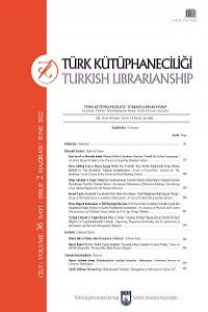Bilgi İle İyileşme: Bibliyoterapi
Bibliyoterapi, bilgi kaynaklarıyla ruha yardım etmek anlamındadır. Bu çalışmanın amacı terapötik amaçlarla kitap kullanımını geliştirmek ve bibliyoterapinin Türkiye’de şu anki durumunu tartışarak önerilerde bulunmaktır. Bununla birlikte bilgi yöneticilerinin bibliyoterapi de nasıl rol alması gerektiğive bibliyoterapinin Türkiye’de tanıtımı için neler yapılması gerektiği üzerine bilgiler verilmektedir.
Anahtar Kelimeler:
Bibliyoterapi, bilgi ile iyileşme, okuma ile iyileşme.
HealingWith Knowledge: Bibliotherapy
Bibliotherapymeans helping to the soul with information sources. The purpose of this study is to explore the use of bookswith therapeutic aims; and to purpose suggestions by discussing the present situation of bibliotherapy in Turkey. However, how should information managers take a part in bibliotherapy and what should they do in introducing bibliotherapy in Turkey
Keywords:
Bibliotheraphy, healing with knowledge, healing with reading.,
___
- Brewster, L. (2008). The reading remedy: Bibliotherapy in practice, Aplis, 21(4) 172-176.
- Bryan, I. A. (1939). Can there be a science of bibliotherapy? Library Journal, 64, 773-777.
- Bulut,S. (2010). Bibliyoterapi yönteminin okullarda psikolojik danışmanlar ve öğretmenler tarafından kullanılması. Elektronik Sosyal Bilimler Dergisi, 9(34), 17-31.
- Campbell, L.F. ve Smith, T. P. (2003). Integrating self-help books into phsychotherapy. Journal of Clinical Psychology in Session, 59(2): 177-186.
- Cilliers, J. (1980). Bibliotherapy for alcoholics and drug addicts (Unpublished doctoral dissertation). Stellenbosch: University of Stellenbosch.
- Diodorus,S. (1933). The library of history, Loeb Classical Library edition,Vol. I 28 Mayıs 2014 tarihinde http://www.rcshafim.org.il/ad/cgypt/institııtions/hoıısc_of_books.htm#library_of_ thebesadresinden erişildi.
- Dökmen, Ü. (2006). Küçük şeyler. 2 bs. İstanbul: Sistem yayıncılık.
- Dökmen,Ü. (1994) Okuma becerisi, ilgisi ve alışkanlığı üzerine psiko-sosyal bir araştırma. Ankara: M.E.B. Yayınları.
- Horne E.M. (1975). A look at bibliotherapy state University of New York at Albany. School of Library and Information Science. Albany: New York.
- Jackson,S. A. ve K. W. Nelson. (2002). Use of children’s literature in a comprehensive school guidence program for young children. Early Childhood Literacy 2001 Yearbook.
- Janaviciene,D. (2010). Bibliotherapy process and type analysis: Review of possibilities to use it in the library. II Tiltai. Klaipeda University, (Lithuanian) 4(53) 119-132.
- Jones, J. L. (2006). A closer look at bibliotherapy. Young Adult Library Services, Fall, 24-27.
- Landreville, P. Landry J. Baillargeon, L. Guerette, A. Matteau, E. (2001). Older adults’ acceptance of psychologiacal and pharmacological treatments for depression. Journals of Genontology Series B, Psychological Sciences and Social Sciences, 56(5):285-291.
- Leedy, J. J. (1973). Poetry the healer. Philadelphia, Toronto: J. B. Lippincott Company.
- Lu, Y. L. (2008). Helping children cope: What is bibliotherapy? Research and Development, Spring, 47-49.
- Marrs, R. W. (1995). A meta-analysis of bibliotherapy studies. American Journal of Community Psychology, 23(6), 846.
- McCulliss, D. (2012).Bibliotherapy:Historical andresearch perspectives.
- Journal of 'Poetry Therapy, 25(1): 23-38.
- Menekay,S. (2009). Ölümün girmesinin yasak olduğu, vasiyetnamelerin hiç açılmadığı şehir: Asklepion- Bergama. Dirim Tıp Gazetesi, 1-4.
- Monroe, E. M. (1971). Reading guidance and bibliotherapy in the hospital and institution libraries. Madison, Wisconsin: University of Wisconsin Library School.
- Opler,P. (1969). The origins and trends of bibliotherapy as a device in mental hospital libraries. MLS thesis,San Jose State College, San Jose CA.
- Öner,U. (2007). Bibliyoterapi. Çankaya Üniversitesi Fen Edebiyat Fakültesi Journal of Arts and Sciences, 7, 133-150.
- Öner, U. (1987). Bibliyoterapi. Ankara Üniversitesi Egitim Bilimleri Fakültesi Dergisi, 20, 143-149.
- Öner,U. ve Yeşilyaprak, B. (2006). Bibliyoterapi: Psikolojik danışma ve rehberlik programlarında çocuk edebiyatından yararlanma. ll. Ulusal Çocuk ve Gençlik Edebiyat Sempozyumu Bildiriler Kitabı içinde (ss. 559-565). Ankara: Ankara Üniversitesi Eğitim Bilimleri Fakültesi.
- Pardeck, J. T. (1993). Using bibliotherapy in clinical practice: A guide to self-help books. Westport, CT: Greenwood Press.
- Rubin, R. J. (1978). Using bibliotherapy: A guide to theory and practice. Phoenix: Oryx Press.
- Russel,D. ve Shrodes, G. (1950). Contributions of research in bibliotherapy to the language arts program. School Review, 58, 411-420.
- Shrodes,C. (1950). Bibliotherapy: A theoretical and clinical-experimental study. Unpublished Ph.D. Dissertation, Universityof California:.
- Swart, M. H. G. (Derleyen). (1984). School media center: Media use in schools.Pretoria: Transvaal School Media Association.
- Weimerskirch, P. J. (1965). Benjamin Rush and John Minson Galt, II: Pioneers of Bibliotherapy in America. Bulletin of the Medical Library Association, 53(4):510-526.
- Wolberg, L. R. (1967). “Hypnoanalysis.” The technique of psychotherapy içinde (ss. 578-582). Vol 2. New York: Grune and Stratton.
- Yeşilyaprak, B. (2009). Bibliyoterapi: Okuma ile sağaltım. 7 Mayıs 2014 tarihinde http://www.binnurvesilvaprak.eom/index.php?view= artiele&eatid = 3 4%3A basin-aeiklamalari&id = 76%3 Apsikoloj ik-danisman-aday lari-nemrut-dagi- ndavdi&format=pdf&option=com_content&Itemid=79 adresinden erişildi.
- Yılmaz, M. (2012). Bibliyoterapi ve bibliyoterapide bilgi yöneticilerinin rolü.Yayımlanmamış Lisans Tezi.Ankara Üniversitesi Sosyal Bilimler Enstitüsü, Ankara.
- Başlangıç: 1952
- Yayıncı: Türk Kütüphaneciler Derneği
Sayıdaki Diğer Makaleler
Medya mesajı, medya masajıdır: McLuhan’ın izinde medyayı anlama kılavuzu.
Kütüphanecilikte STK İşbirliği: “Güçlü Dernekler, Güçlü Toplumlar
Bilgi İle İyileşme: Bibliyoterapi
Orda Bir Ahmet Gürlek Var Uzakta!
İlkokul ve Ortaokul Son Sınıf Öğrencilerinde Metaforik Algı Olarak Kitap
Mustafa BEKTAŞ, Alpaslan OKUR, Buket KARADAĞ
Eleştirel Okumanın Eğitimle İlişkisi ve Okul Kütüphanecilerinin Rolü
IFLA Başkanlık Toplantıları ve 2014 İstanbul Çalışma Ziyareti
50. Kütüphane Haftası'nın Ardından
Almanya İzlenimleri: Kütüphaneciler için Mesleki Deneyim ve Gelişim Fırsatı
